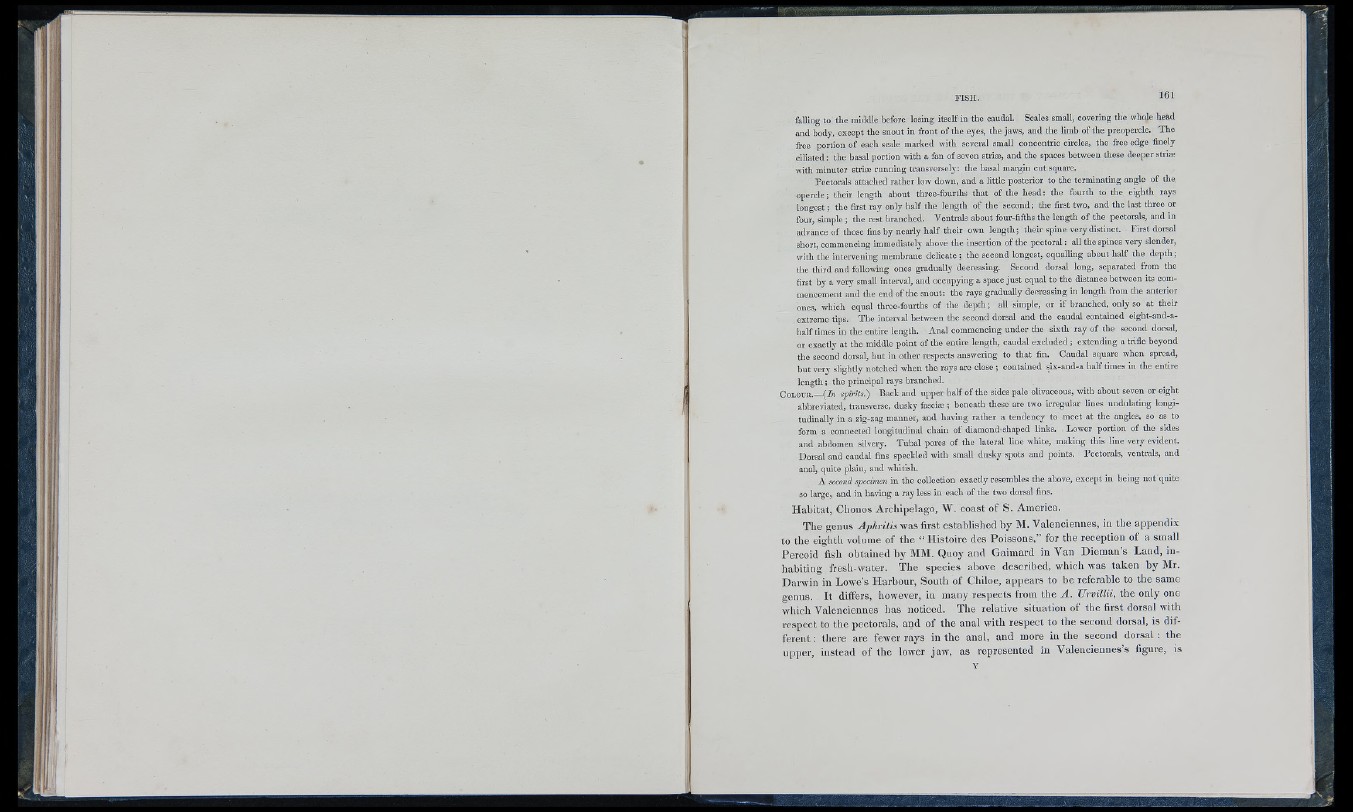
Il
if
falling to the middle before losing itself in the caudal. Scales small, covering the whole head
and body, except the snout in front of the eyes, the jaws, and the limb of the preopercle. The
free portion of each scale marked with several small concentric circles, the free edge finely
ciliated : the basal portion with a fan of seven striæ , and the spaces between these deeper striæ
with m inuter striæ running transversely: the basal margin cut square.
Pectorals attached rather low down, and a little posterior to the term inating angle of the
opercle; their length about three-fourths that of the head: the fourth to the eighth rays
longest; the first ray only half the length of the second; the first two, and the last three or
four, simple ; the rest branched. Ventrals about four-fifths tbe length of the pectorals, and in
advance of those fins by nearly half their own length ; their spine very distinct. First dorsal
short, commencing immediately above tbe insertion of the pectoral : all the spines very slender,
with the intervening membrane delicate ; the second longest, equalling about half the depth ;
the third and following ones gradually decreasing. Second dorsal long, separated from the
first by a very small interval, and occupying a space just equal to the distance between its commencement
and the end of the snout: the rays gradually decreasing in lengtli from the anterior
ones, which equal three-fourths of the d ep th ; all simple, or if branched, only so at their
extreme tips. T he interval between the second dorsal and the caudal contained eight-and-a-
half times in the entire length. A nal commencing under the sixth ray of the second dorsal,
or exactly at the middle point of the entire length, caudal excluded ; extending a trifle beyond
the second dorsal, but in other respects answering to that fin. Caudal square when spread,
but very slightly notched when the rays are close ; contained six-and-a half times in the entire
length ; the principal rays branched.
C o l o u r .— (/n spirits.) Back and upper half of the sides pale oliyaceons, with ahont seven or eight
abbreviated, transverse, dusky fasciæ ; beneath these are two irregular lines undulating longi-
tudinally in a zig-zag manner, and having rather a tendency to meet at the angles, so as to
form a connected longitudinal chain of diamond-shaped links. Lower portion of the sides
and abdomen silvery. T ubal pores of the lateral line white, making this line very evident.
Dorsal and caudal fins speckled with small dusky spots and points. Pectorals, ventrals, and
anal, quite plain, and whitish.
A second specimen in the collection exactly resembles the above, except in being not quite
so large, and in having a ray less in each of the two dorsal fins.
Habitat, Chonos Archipelago, W. coast of S. America.
The genus A p h ritis was first estahlislied hy M. Valenciennes, in the appendix
to the eighth volume of the “ Histoire des Poissons,” for the reception of a small
Percoid fish obtained by MM. Quoy and Gaimard in Van Dieman’s Land, inhabiting
fresh-water. The species above described, which was taken by Mr.
Darwin in Lowe’s Harbour, South of Chiloe, appears to be referable to the same
genus. It differs, liowever, in many respects from the A . JJrmlUi, the only one
whicli Valenciennes has noticed. The relative situation of the first dorsal with
respect to the pectorals, and of the anal with respect to the second dorsai, is dii-
ferent : tliere are fewer rays in the anal, and more in the second dorsai : the
upper, instead of the lower jaw, as represented in Valenciennes’s figure, is